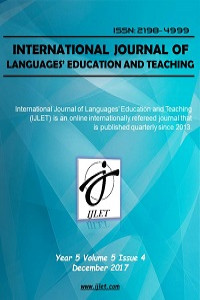Measuring Technology Acceptance Level of Teachers by Using Unified Theory of Acceptance and Use of Technology
Öz
Technology has undergone a lot of radical changes in the last years which have caused the implemention of new paradigms in different sectors. It is almost impossible for education not to be affected from this change in technology. It has shifted from the traditional applications to the technology use in the classrooms. In this case, teachers’ role in the application of technology into education has become an essential part of the research in the field. Also, in higher education, teachers become the key factors to the effective use of technology in the teaching and learning processes. Thus, teachers’ technology acceptance level remains an important issue. The term, technology acceptance refers to the adoption and use of technologies in the way they were designed for. The purpose of this study is to examine the technology acceptance level of teachers at Anadolu University School of Foreign Languages to test the Unified Theory of Acceptance and Use of Technology (UTAUT) that determines the variables influencing individuals’ technology acceptance. Firstly, a Likert scale type of scale was administered to measure UTAUT and the attitudes of teachers towards technology. The participants are the 44 lecturers who have started using technology recently at Anadolu University School of Foreign Languages. The findings reveal that the overall technology acceptance level of participants is average.
Anahtar Kelimeler
Information and communication technologies Teachers’ acceptance level of technology UTAUT EFL
Kaynakça
- Ajzen, I. (1991). The theory of planned behavior. Organizational Behavior and Human Decision Processes, 50, 179–211.
- Akbar, F. (2013). What affects students’ acceptance and use of technology? Dietrich College Honors Theses. Carnegie Mellon University
- Bandura, A. (1986). Social foundations of thought and action: A social cognitive theory. Englewood Cliffs, NJ: Prentice Hall.
- Balanskat, A., Blamire, R., & Kefala, S. (2006). The ICT Impact Report– A review of ICT impact on schools in Europe. Retrieved July, 16, 2008.
- Belz, J. A. (2003). Linguistic graduation and the development of intercultural competence in Internetmediated foreign language learning. Unpublished manuscript, the Pennsylvania State University.
- Bates, T., & Epper, R.(2001). Teaching faculty how to use technology: Best practices from leading institutions. Greenwood Publishing Group.
- Bingimlas, K. A. (2009). Barriers to the successful integration of ICT in teaching and learning environments: A review of the literature. Eurasia Journal of Mathematics, Science & Technology Education, 5(3), 235-245.
- Birch, A. and Irvine, V. (2009), “Preservice teachers’ acceptance of ICT integration in the classroom: applying the UTAUT model”, Educational Media International, Vol. 46 No. 4, pp. 295-315.
- Bransford, J., Brown, A. L., & Cocking, R. R. (Eds.). (2000). How people learn: Brain, mind, experience, and school (2nd ed.). Washington, D.C.: National Academy Press.
- Brown, S. A., & Venkatesh, V. (2005). Model of adoption of technology in households: A baseline model test and extension incorporating household life cycle. MIS quarterly, 399-426.
- Carter, A., Cotton, S. R., Gibson, P., O’Neal, L. J., Simoni, Z., Stringer, K., & Watkins, L. S. (2013). Integrating Computing Across the Curriculum: Incorporating Technology. Transforming K-12 classrooms with digital technology, 165.
Measuring Technology Acceptance Level of Teachers by Using Unified Theory of Acceptance and Use of Technology
Öz
Anahtar Kelimeler
Information and communication technologies Teachers’ acceptance level of technology UTAUT EFL
Kaynakça
- Ajzen, I. (1991). The theory of planned behavior. Organizational Behavior and Human Decision Processes, 50, 179–211.
- Akbar, F. (2013). What affects students’ acceptance and use of technology? Dietrich College Honors Theses. Carnegie Mellon University
- Bandura, A. (1986). Social foundations of thought and action: A social cognitive theory. Englewood Cliffs, NJ: Prentice Hall.
- Balanskat, A., Blamire, R., & Kefala, S. (2006). The ICT Impact Report– A review of ICT impact on schools in Europe. Retrieved July, 16, 2008.
- Belz, J. A. (2003). Linguistic graduation and the development of intercultural competence in Internetmediated foreign language learning. Unpublished manuscript, the Pennsylvania State University.
- Bates, T., & Epper, R.(2001). Teaching faculty how to use technology: Best practices from leading institutions. Greenwood Publishing Group.
- Bingimlas, K. A. (2009). Barriers to the successful integration of ICT in teaching and learning environments: A review of the literature. Eurasia Journal of Mathematics, Science & Technology Education, 5(3), 235-245.
- Birch, A. and Irvine, V. (2009), “Preservice teachers’ acceptance of ICT integration in the classroom: applying the UTAUT model”, Educational Media International, Vol. 46 No. 4, pp. 295-315.
- Bransford, J., Brown, A. L., & Cocking, R. R. (Eds.). (2000). How people learn: Brain, mind, experience, and school (2nd ed.). Washington, D.C.: National Academy Press.
- Brown, S. A., & Venkatesh, V. (2005). Model of adoption of technology in households: A baseline model test and extension incorporating household life cycle. MIS quarterly, 399-426.
- Carter, A., Cotton, S. R., Gibson, P., O’Neal, L. J., Simoni, Z., Stringer, K., & Watkins, L. S. (2013). Integrating Computing Across the Curriculum: Incorporating Technology. Transforming K-12 classrooms with digital technology, 165.
Ayrıntılar
| Birincil Dil | İngilizce |
|---|---|
| Konular | İkinci Bir Dil Olarak İngilizce, Dil Çalışmaları (Diğer) |
| Bölüm | Araştırma Makalesi |
| Yazarlar | |
| Yayımlanma Tarihi | 30 Aralık 2017 |
| Yayımlandığı Sayı | Yıl 2017 Cilt: 5 Sayı: 4 |


